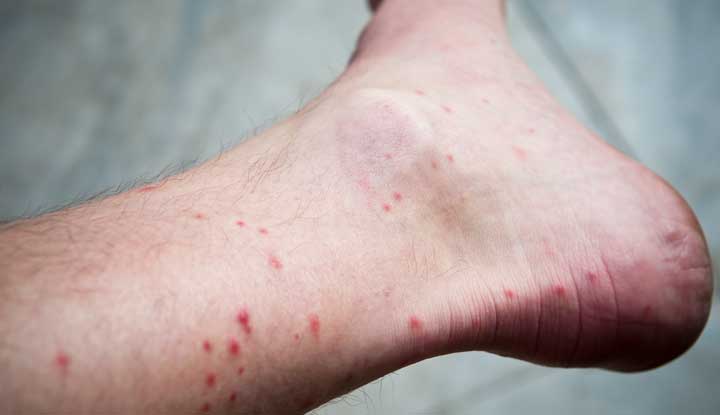Flea bites are more than just a nuisance. These tiny pests can turn your day into an itchy nightmare, especially if you’re allergic. Knowing how to identify their bites, soothe the irritation, and prevent future encounters is key to staying comfortable. Here’s your guide to handling flea bites like a pro.
 |
| Fleas generally bite on human legs |
Spotting Flea Bites
Flea bites often appear as small, red bumps clustered in groups of three or four, usually around ankles, legs, or waist. They might look like tiny red dots with a faint halo and feel intensely itchy. Unlike mosquito bites, flea bites don’t swell much but can cause a rash if scratched repeatedly. Pets scratching excessively or red spots on their skin are telltale signs of a flea problem at home.
Key identifiers:
Location: Lower body areas (ankles, feet).
Pattern: Grouped or linear clusters.
Sensation: Immediate itching or burning.
Soothe the Itch Fast
Resist the urge to scratch—it worsens irritation and raises infection risk. Instead, try these steps:
Wash the Area: Use mild soap and cool water to cleanse bites. Pat dry gently.
Cold Compress: Apply ice wrapped in cloth for 10 minutes to reduce swelling.
Over-the-Counter Creams: Hydrocortisone or calamine lotion eases itching.
Oral Antihistamines: Options like Benadryl help if itching disrupts sleep.
Natural Remedies: Aloe vera gel or diluted apple cider vinegar offer relief.
For severe reactions (blisters, fever), consult a doctor immediately.
Stop Fleas in Their Tracks
Preventing fleas is easier than battling an infestation. Start here:
1. Treat Pets:
Use vet-approved flea collars, topical treatments, or oral medications.
Wash pet bedding weekly in hot water.
2. Clean Your Space:
Vacuum carpets, furniture, and crevices daily. Dispose of the vacuum bag outside.
Steam-clean upholstery to kill eggs and larvae.
3. Outdoor Defense:
Mow lawns short and remove debris where fleas thrive.
Use nematodes (natural predators) in gardens.
4. Long-Term Prevention:
Wash your clothes and linens in hot water after outdoor activities.
Consider professional pest control for severe infestations.
Myths vs. Facts
Myth: Fleas only bite pets.
Fact: They bite humans too, especially in pet-free homes if brought in via clothing.Myth: Fleas die in winter.
Fact: They survive indoors year-round, thriving in warm, humid spaces.
When to Seek Help
Most flea bites heal within 1–2 weeks, but persistent symptoms like pus, fever, or hives warrant medical attention. Allergic individuals may need prescription steroids or antibiotics.
Final Tips
Stay Vigilant: Check pets and living spaces regularly.
Act Fast: Treat flea bites immediately to avoid complications.
Prevent Proactively: Consistency is key—repeat cleaning and treatments as needed.
By understanding flea behavior and acting swiftly, you can minimize discomfort and keep your home pest-free. Remember, prevention isn’t a one-time task but a habit that protects both you and your pets.



No comments:
Post a Comment